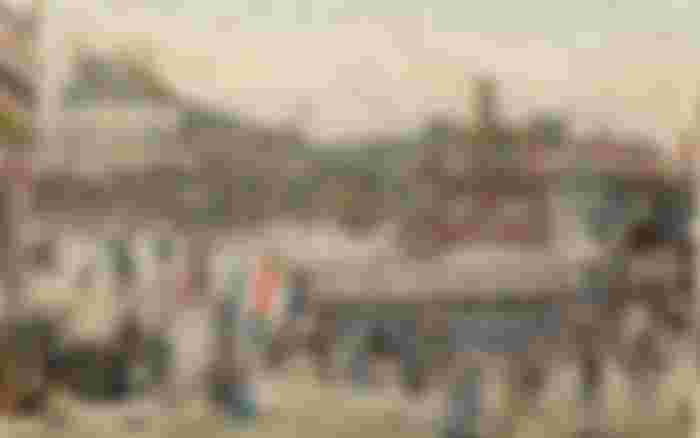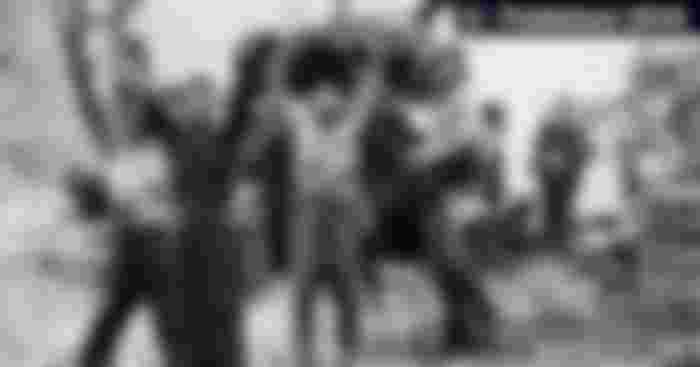THE "9TH OF THERMIDOR" OF THE FRENCH REVOLUTION
July 27, 1794

The Revolution that caused nearly eight months of bloodshed of thousands of French in the Reign of Terror will end with the fall of one man behind it all-Maximilien Robespierre. Since Robespierre implemented the Law of 22 Prairial in the Committee on Public Safety, more than in 1793 were taken to the guillotine from June to July 1794. Robespierre also did not appear at the National Convention or even at the Committee for a long time, so the Robespierre's enemies made a way for him to disappear, fearing that they might be the next victim of Robespierre's bloody kind of justice.
July 27, 1794 when Robespierre arrived, accompanied by revolutionary ally and also deputy of the Convention Louis Antoine de Saint-Just at the National Convention. There, Robespierre defended himself from accusations against him that he was a dictator, and revealed a large conspiracy by members of the Convention against the Republic, and he carried with him a list of those he identified as involved in that conspiracy, but the his long speech of accusation was silenced when those in the Convention asked to name his alleged accomplices. Fearing that they might be among those referred to by Robespierre, they angrily expelled from the Convention Robespierre, his brother Augustin Robespierre, Saint-Just, and another ally of the Convention, Georges Couthon. And on the same day, they permanently removed Robespierre and all his supporters as members of the Convention and ordered their arrest. At the same time, Robespierre went to the Hôtel de Ville or the Paris municipality to defend themselves from the Convention's plot against him, relying on military support for him to return to government. The Paris government did not follow the Convention's order to imprison Robespierre, and instead they supported it.
When it became known that the Paris government had sided with Robespierre, the Convention immediately ordered the arrest of Robespierre as criminals at the Hotel de Ville as soon as possible that same night. Before dawn, soldiers loyal to the Convention stormed the Paris municipality, and after a few minutes of confrontation, they arrested Robespierre and his supporters. One of his supporters jumped out the window, while another shot himself, and Robespierre, was hit so hard by a gunshot wound to his right jaw that he almost died. It is still unclear whether he fought the soldiers or attempted suicide.
From that moment on, the gruesome day of the end of the bloody Terror chief architect will be swallowed up by the own monster he created. Called the "Thermidorian Reaction", according to the calendar of the revolutionary Republic, the fall and the end of Robespierre.
THE IGLESIA NI CRISTO WAS ESTABLISHED
July 27, 1914

Today is the 107th anniversary of Iglesia ni Cristo, founded by Felix Ysagun Manalo in Punta, Sta. Ana, Manila on July 27, 1914. Manalo registered INC with the Bureau of Commerce as a sole corporation, in response to questioning the legality of the said church.
For INC followers, Felix Manalo is considered God’s messenger to fulfill the prophecy that Christianity would be brought to the Far East, and INC is the original church founded by Jesus Christ that was said to have been discontinued before, and its members only he will be saved on the Day of Judgment. It rejects Catholic doctrines, such as the veneration of images of saints and the Blessed Trinity, but it recognizes Jesus Christ as the son of God and God's only Mediator with mankind.
INC started with a small following and Ka Felix served as a minister spreading the word of God to his first local in Santa Ana, Manila. Eventually, their membership increased, within 1924, INC had approximately 3,000-5,000 members from 43 or 45 locals in Manila and neighboring provinces. By 1936 their number had reached 85,000 members and increased even more in 1954 to an estimated 250,000. The first INC congregation or local outside Luzon was established in 1937. It was also the first local to be established in the Visayas. Their first mission in Mindanao was carried out in 1946. And in 1948, their first concrete chapel was built in Sampaloc, Manila.
Beginning in the 1950s, Ka Felix's health began to decline so his son Ka Eraño Manalo took over as general minister. Ka Felix Manalo passed away on April 12, 1963, due to an ulcer.
INC’s first overseas mission was conducted in 1968 in celebration of their 54th anniversary, and in July 1973, the first INC’s overseas mission was established in Honolulu, Hawaii, and they later also established locally in San Francisco, California.
The Ministerial Institute of Development, or New Era University College of Evangelical Ministry was established in 1974 in Quiapo, Manila. It moved to its current location in 1978. In 1975, INC established a higher education institution New Era University and had five extension schools in Bulacan, Cavite, Laguna, Pampanga, and Rizal.
In 1971 the Central Office building of Iglesia ni Cristo was built, and 15 years later, their Central Temple was built to add to their complex. Construction of the Tabernacle, a tent-like multipurpose building that can accommodate 4,000 people, was completed in 1989. New Era University is located in the same complex. In 1993, the New Era General Hospital was built, which provides medical services to sick brothers and sisters to this day.
With the passing of Ka Eraño Manalo on August 31, 2009, his son Ka Eduardo Manalo, who is still in his current office, succeeded him as INC general minister. In the 2015 official census, 2.65% of the total Philippine population is affiliated with INC, the third largest religion in the Philippines, while an estimated more than three million people from 156 countries around the world, excluding North Korea and strictly Islamic countries, its members.
In celebration of INC's centenary, the largest indoor arena in the entire Philippines, the Philippine Arena, was built at their complex in Bulacan's Ciudad de Victoria. Construction was completed on May 30, 2014, and inaugurated on July 21, 2014. It can accommodate approximately 55,000 people. Prescribed in force by Republic Act no. 9645 signed by President Gloria Macapagal-Arroyo in 2009 the 27th of July as Iglesia ni Cristo Day as a special working holiday, and became a special non-working holiday in 2014 in commemoration of the centenary birthday of INC.
PANTALEON GARCIA WAS BORN
July 27, 1856

Today is the 165th anniversary of the birth of General Pantaleon Garcia, who was born in the city of Imus, Cavite in 1856. Garcia completed an education course at the Escuela Normal run by Jesuit priests, and served as a teacher in the town of Silang, Cavite in 1875.
It was 1896 when Garcia joined the Katipunan, and his "baptism by fire" began in Silang, Cavite where Garcia and his men captured the Spanish fort there using only machetes, bamboo spears, and small guns. Garcia was promoted to the rank of Colonel for his successful defense and defeat of Spanish forces at Mt. Puray in Montalban, in February 1897. Colonel Garcia was also among the generals who planned to defend the Filipino revolutionaries in Pasong Santol in Imus, Cavite in March 1897, but Pasong Santol was later defeated and fell to the Spaniards.
Colonel Garcia also led the revolutionary forces in Kalookan, Novaliches and Navotas. General Emilio Aguinaldo also appointed Colonel Garcia to form a committee to investigate Andres Bonifacio's case against the revolutionary government, and he also recommended the indictment of the Bonifacio brothers in a military court, headed by General Mariano Noriel.
Colonel Garcia was also among the retreating revolutionaries to Biak-na-Bato in San Miguel, Bulacan, and when the first session of the Malolos Congress opened, General Garcia was appointed as the representative of Cavite province. President Aguinaldo elevated Garcia to the rank of Brigadier General, and appointed him one of the leaders in the recovery of Manila from the Americans during the Filipino-American War. Garcia rose to the rank of Major General, and became the chief general of the Filipino forces in central Luzon when the guerrilla system was implemented. The Americans captured General Garcia in May 1900 in Jaen, Nueva Ecija.
Garcia entered politics after the war, when he was elected mayor of the town of Imus, Cavite in 1904, and became the huez de paz of the said town in 1906. After that, Garcia lived privately with his wife Valeriana Elises and they have three children.
General Pantaleon Garcia passed away on August 16, 1936. The headquarters of the Philippine National Police and a high school campus in the city of Imus, Cavite were named after General Garcia.
THE END OF THE KOREAN WAR
July 27, 1953

After three years of bloody war on the Korean peninsula, the conflict between the two Koreas came to an end with an armistice, signed on this day in 1953. Armistice was adopted in Panmunjom, a small town in North Korea that was signed past 10:00 a.m., by delegates from North Korea, China and the United States and the UN Peacekeeping Force, signaling an end to gunfire across the Korean peninsula.
The signed armistice also states the demarcation of a military demarcation line at the 38th parallel, which is considered the most armed border in the world. The armistice also ordered the repatriation of prisoners of War held by the two Koreas within 60 days after the armistice was ratified, but this was not carried out. This armistice is only to end the ongoing war, not to settle the conflict between the two Koreas. South Korea did not participate in the signing of the armistice without it being accepted by President Syngman Rhee, who wanted to reunite the two Koreas by force.
Although the Korean War ended in armistice, no formal peace agreements or even normalization of relations between the two Koreas were signed, so the state of war between North and South Korea still remains. Relations between China and South Korea have returned to normal with the effect of the peace agreement signed in 1992, while South Korea accuses Pyongyang of violating armistice provisions.
More than 170,000 soldiers were killed on the side of South Korea, the United States and its allies, while an estimated more than 390,000 North Koreans, Chinese and their allies were killed in this war, and more than three million civilians were killed. The United States, North and South Korea are currently commemorating the day of the end of the Korean War and the veterans who fought in said war.
References:
Llewellyn, J., & Thompson, S. (2020, August 21). The fall of Robespierre. Alpha History. https://alphahistory.com/frenchrevolution/fall-of-robespierre/
Wikipedia (n.d.). Fall of Maximilien Robespierre. https://en.m.wikipedia.org/wiki/Fall_of_Maximilien_Robespierre
Iglesia Ni Cristo (n.d.). History. https://iglesianicristo.net/history/
The Kahimyang Project (n.d.). Today in Philippine history, July 27, 1914. Felix Manalo founded Iglesia ni Cristo ni Punta, Sta. Ana, Manila.
Imus City Government (n.d.). Heroes of Imus. https://imus.gov.ph/heroes-of-imus/
History.com Editors (n.d.). This day in history armistice ends the Korean war. History.com. https://www.google.com/amp/s/www.history.com/.amp/this-day-in-history/armistice-ends-the-korean-war
Wikipedia (n.d.). Korean armistice agreement. https://en.m.wikipedia.org/wiki/Korean_Armistice_Agreement



